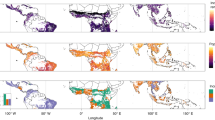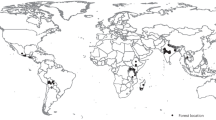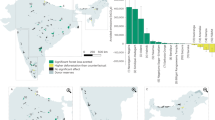Abstract
Climate change and biodiversity loss are leading environmental crises that converge most critically in tropical forests. Policies for reducing emissions from deforestation and degradation are often portrayed as win–win solutions for forest-based climate change mitigation and biodiversity conservation. However, the win–win narrative has obscured necessary trade-offs and a range of alternative policy approaches, insulating policymakers from difficult, potentially unpopular decisions. We provide a typology that characterizes the five underlying policy approaches for linking forest-based climate change mitigation and biodiversity conservation and their related trade-offs. Such clarification will enable policymakers and stakeholders to better articulate their positions in the protracted and controversial biodiversity co-benefits debate that is at the centre of contemporary conservation efforts.
This is a preview of subscription content, access via your institution
Access options
Subscribe to this journal
Receive 12 print issues and online access
$209.00 per year
only $17.42 per issue
Buy this article
- Purchase on Springer Link
- Instant access to full article PDF
Prices may be subject to local taxes which are calculated during checkout

Similar content being viewed by others
References
Outcome of the Work of the Ad Hoc Working Group on Long-term Cooperative Action under the Convention [-/CP.17] (UNFCCC, 2011); available at http://unfccc.int/files/meetings/durban_nov_2011/decisions/application/pdf/cop17_lcaoutcome.pdf.
Miles, L. & Kapos, V. Reducing greenhouse gas emissions from deforestation and forest degradation: Global land-use implications. Science 320, 1254–1255 (2008).
Hirsch, P. D. et al. Acknowledging conservation trade-offs and embracing complexity. Conserv. Biol. 25, 259–264 (2010).
Biodiversity and Livelihoods: REDD-plus Benefits (Convention on Biological Diversity Secretariat and Deutsche Gesellschaft fur Internationale Zusammernarbeit, 2011); available at http://www.cbd.int/doc/publications/for-redd-en.pdf.
Dickson, B., Dunning, E., Killen, S., Miles, L. & Pettorelli, N. Carbon Markets and Forest Conservation: A Review of the Environmental Benefits of REDD Mechanisms (United Nations Environmental Programme — World Conservation Monitoring Centre, 2009); available at http://www.unep-wcmc.org/medialibrary/2010/10/05/d26fb1d3/Environmental%20Benefits%20from%20REDD.pdf.
Pistorius, T., Schmitt, C. B, Benick, D. & Entenmann, S. Greening REDD+ (Univ. Freiburg, 2010); available at http://www.cbd.int/doc/meetings/for/ewredd-01/other/ewredd-01-uni-freiburg-en.pdf.
Adams, W. M. et al. Biodiversity conservation and the eradication of poverty. Science 306, 1146–1149 (2004).
Draft Decision on Guidance on Systems for Providing Information on How Safeguards are Addressed and Respected and Modalities Relating to Forest Reference Emission Levels and Forest Reference Levels as Referred to in Decision 1/CP.16, Appendix I (UNFCCC, 35th Meeting of the Subsidiary Body for Scientific and Technological Advice, 2011); available at http://unfccc.int/files/meetings/durban_nov_2011/decisions/application/pdf/cop17_safeguards.pdf.
Grainger, A. et al. Biodiversity and REDD at Copenhagen. Curr. Biol. 19, R974–R976 (2009).
Estimating the Opportunity Costs of REDD+ (World Bank, 2011); available at http://wbi.worldbank.org/wbi/learning-product/estimating-opportunity-costs-redd.
Lindenmayer, D. B. et al. Avoiding bio-perversity from carbon sequestration solutions. Conserv. Lett. 5, 28–36 (2012).
Noss, R. F. Indicators for monitoring biodiversity: A hierarchical approach. Conserv. Biol. 4, 355–364 (1990).
Cerbu, G. A., Swallow, B. M. & Thompson, D. Y. Locating REDD: A global survey and analysis of REDD readiness and demonstration activities. Environ. Sci. Policy 14, 168–180 (2011).
http://www.conservation.org/learn/climate/solutions/mitigation/Pages/climate_REDD.aspx.
Christophersen, T. & Stahl, J. REDD-plus and Biodiversity (Secretariat of the Convention on Biological Diversity, 2011); available at http://www.cbd.int/doc/publications/cbd-ts-59-en.pdf.
Ballesteros, A., Polycarp, C., Stasio, K., Chessin, E. & Easton, C. Summary of Developed Country 'Fast-Start' Climate Finance Pledges (World Resources Institute, 2011); available via http://go.nature.com/Ehfu3W.
James, A., Gaston, K. J. & Balmford, A. Can we afford to conserve biodiversity? Bioscience 51, 43–52 (2001).
Norwegian Climate and Forest Initiative (Government of Norway Ministry of the Environment and Ministry of Foreign Affairs, 2011); available at http://www.regjeringen.no/upload/MD/Vedlegg/Klima/klima_skogprosjektet/mai2010.pdf.
Phelps, J., Friess, D. A. & Webb, E. L. Win-win REDD+ approaches belie carbon-biodiversity trade-offs. Biol. Conserv. http://dx.doi.org/10.1016/j.biocon.2011.12.031 (in the press).
Busch, J., Godoy, F., Turner, W. R. & Harvey, C. A. Biodiversity co-benefits of reducing emissions from deforestation under alternative reference levels and levels of finance. Conserv. Lett. 4, 101–115 (2011).
Zwick, S. UN Biodiversity boss says convergence with carbon markets could turn REDD+ into win-win for species. Ecosystems Marketplace (2010); available via http://go.nature.com/rAgpyH.
Carbon and Biodiversity: A Demonstration Atlas (eds Kapos, V. et al.) (United Nations Environmental Programme — World Conservation Monitoring Centre, 2008); available at http://www.unep.org/pdf/carbon_biodiversity.pdf.
Strassburg, B. N. B. et al. Global congruence of carbon storage and biodiversity in terrestrial ecosystems. Conserv. Lett. 3, 98–205 (2009).
Venter, O. et al. Carbon payments as a safeguard for threatened tropical mammals. Conserv. Lett. 2, 123–129 (2009).
Strassburg, B. B. N. et al. Impacts of incentives to reduce emissions from deforestation on global species extinctions. Nature Clim. Change 2, 350–355 (2012).
Miles, L. & Dickson, B. REDD-plus and biodiversity: Opportunities and challenges. Unasylva 236, 56–63 (2010).
Alexander, S. et al. Opportunities and challenges for ecological restoration within REDD+. Restoration Ecol. 19, 683–689 (2011).
Van Oosterzee, P., Preece, N. & Dale, A. Catching the baby: Accounting for biodiversity and the ecosystem sector in emissions trading. Conserv. Lett. 3, 83–90 (2010).
Chair's Summary on the Workshop on Capturing Carbon and Biodiversity Benefits to Reduce Deforestation (Organization for Economic Co-operation and Development, 2008); available at http://www.oecd.org/env/biodiversity.
Somorin, O. A. et al. The Congo Basin forests in a changing climate: Policy discourses on adaptation and mitigation (REDD+). Glob. Environ. Change 22, 288–298 (2012).
Ebeling, J. & Fehse, J. Challenges for a Business Case for High-Biodiversity REDD Projects and Schemes (Ecosecurities, 2009); available at http://www.cbd.int/forest/doc/other/ecosecurities-report-2009-02-en.pdf.
Karousakis, K. Promoting Biodiversity Co-Benefits in REDD OECD Environment Working Paper 11 (Organization for Economic Co-operation and Development, 2009); available at http://www.cbd.int/forest/doc/other/ecosecurities-report-2009-02-en.pdf.
Strassburg, B., Turner, K., Fisher, B., Schaeffer, R. & Lovett, A. Reducing emissions from deforestation — the “combined incentives” mechanism and empirical simulations. Glob. Environ. Change 19, 254–278 (2009).
Foster, M. et al. Exploring the relationship between avoided carbon emissions potential and biodiversity value — is there a role for biodiversity in REDD? IOP C. Ser. Earth Env. 6, 152005 (2009).
Venter, O. et al. Harnessing carbon payments to protect biodiversity. Science 326, 2368 (2009).
Sangermano, F., Toledano, J. & Eastman, J. R. Land cover change in the Bolivian Amazon and its implications for REDD+ and endemic biodiversity. Landscape Ecol. http://dx.doi.org/10.1007/s10980-012-9710-y (in the press).
Larsen, F. W., Londono-Murcia, M. C. & Turner, W. R. Global priorities for conservation of threatened species, carbon storage, and freshwater services: Scope for synergy? Conserv. Lett. 4, 355–363 (2011).
Thompson, I., Mackey, B., Mosseler, A. & McNulty, S. Forest Resilience, Biodiversity, and Climate Change (Convention on Biological Diversity Technical Series 43, 2009); available at http://www.cbd.int/cooperation/pavilion/nagoya-presentations/2010-10-19-REDD-Thompson-en.PDF.
Waldon, J., Miller, B. W. & Miller, C. M. A model biodiversity monitoring protocol for REDD projects. Trop. Conserv. Sci. 4, 254–260 (2011).
Paoli, G. D. et al. Biodiversity conservation in the REDD+. Carbon Bal. Manag. 5, http://dx.doi.org/10.1186/1750-0680-5-7 (2010).
Siikamaki, J. & Newbold, S. C. Potential biodiversity benefits from international programs to reduce carbon emissions from deforestation. Ambio 41, 78–89 (2012).
Phelps, J., Guerrero, M. C., Dalabajan, D. A., Young, B. & Webb, E. L. What makes a REDD country? Glob. Environ. Change 20, 322–332 (2010).
Stewart, C., Lindhe, A. & Cura, A. REDD+ Co-benefits and the High Conservation Value Concept (Proforest, 2010); available at http://www.proforest.net.
Obersteiner, M. et al. On fair, effective and efficient REDD mechanism design. Carbon Bal. Manag. 4, http://dx.doi.org/10.1186/1750-0680-4-11 (2009).
Angelsen, A. Streck, C., Peskett, L., Brown, J. & Luttrell, C. in Moving Ahead with REDD: Issues, Options and Implications (ed. Angelsen, A.) Ch. 4, 31–40 (Center for International Forestry Research, 2008); available at http://www.cifor.org/publications/pdf_files/Books/BAngelsen0801.pdf.
Harvey, C. A., Dickson, B. & Kormos, C. Opportunities for achieving biodiversity conservation through REDD. Conserv. Lett. 3, 53–61 (2010).
Collins, M. B., Milner-Gulland, E. J., Macdonald, E. A. & Macdonald, D. W. Pleiotropy and charisma determine winners and losers in the REDD+ game: All biodiversity is not equal. Trop. Conserv. Sci. 4, 261–266 (2011).
Submission to the UNFCCC on Methodological Guidance for Activities Relating to REDD-plus, Specifically Related to Systems for Providing Information on how Safeguards Referred to in Appendix I to UNFCCC Decision 1/CP.16 are Addressed and Respected (Secretariat of the Convention on Biological Diversity, 2011); available at http://www.cbd.int/forest/doc/2011-09-26-cbd-submission-unfccc-reddplus-en.pdf.
Meger, E., Dutschke, M. & Verchot, L. Options for REDD+ voluntary certification to ensure net GHG benefits, poverty alleviation, sustainable management of forests and biodiversity conservation. Forests 2, 550–577 (2011).
Ferraro, P. J. & Kiss, A. Direct payments to conserve biodiversity. Science 298, 1718–1719 (2002).
Brosius, J. P., Tsing, A. L. & Zerner, C. Communities and Conservation: Histories and Politics of Community-Based Natural Resource Management (Altamira, 2005).
Phelps, J., Webb, E. L. & Koh, L. P. Risky business: An uncertain future for biodiversity conservation through REDD+. Conserv. Lett. 4, 88–94 (2011).
REDD+ Partnership Workshop on Safeguards and REDD+ (REDD+ Partnership, 2011); available at www.reddpluspartnership.org/65563.
Gardner, T. et al. A framework for integrating biodiversity concerns into national REDD+ programmes. Biol. Conserv. http://dx.doi.org/10.1016/j.biocon.2011.11.018 (in the press).
Miles, L., Dunning, E., Doswald, N. & Osti, M. A Safer Bet for REDD+: Review of the Evidence on the Relationship between Biodiversity and the Resilience of Forest Carbon Stocks (UN-REDD Programme and UNEP-World Conservation Monitoring Center, 2010); available at http://www.unep-wcmc.org/multiple-benefits-series-10_638.html.
Joppa, L. N., Loarie, S. R. & Pimm, S. L. On population growth near protected areas. PLoS ONE 4, e4279 (2009).
Draft Social and Environmental Principles and Criteria Ver. 3 (UN-REDD Programme, 2011); available at http://www.un-redd.org/Multiple_Benefits_SEPC/tabid/54130/Default.aspx.
Dialogue on the Status and Role of Public and Private Finance to Reduce Forest Loss and Degradation (Rights and Resources Initiative, 2011); available at http://www.rightsandresources.org/events.php?id=457.
Analysis of the Outcome of Panama City Climate Negotiations (Conservation International, 2011).
Philippines National REDD+ Strategy (Non-Timber Forest Products Exchange Program, 2010); available at http://www.ntfp.org/coderedd/the-philippine-national-redd-plus-strategy.
Price, J. et al. Identifying Biodiversity Benefits of REDD in Demonstration Activities (UNEP — World Conservation Monitoring Centre, 2008); available at http://unfccc.meta-fusion.com/kongresse/SB28/downl/080604_SB28_REDD_Jeff_Price.pdf.
Ebeling, J. & Yasue, M. Generating carbon finance through avoided deforestation and its potential to create climatic, conservation and human development benefits. Phil. Trans. R. Soc. B 363, 1917–1924 (2008).
Hamilton, K., Sjardin, M., Peters-Stanley, M. & Marcello, T. Building Bridges: State of the Voluntary Carbon Markets 2010 (Ecosystem Marketplace and Bloomberg New Energy Finance, 2010); available at http://www.forest-trends.org/publication_details.php?publicationID=2433.
Bekessy, S. A. & Wintle, B. A. Using carbon investment to grow the biodiversity bank. Conserv. Biol. 22, 510–513 (2008).
Author information
Authors and Affiliations
Corresponding authors
Ethics declarations
Competing interests
The authors declare no competing financial interests.
Rights and permissions
About this article
Cite this article
Phelps, J., Webb, E. & Adams, W. Biodiversity co-benefits of policies to reduce forest-carbon emissions. Nature Clim Change 2, 497–503 (2012). https://doi.org/10.1038/nclimate1462
Published:
Issue Date:
DOI: https://doi.org/10.1038/nclimate1462
This article is cited by
-
Carbonservation with Demonstrated Biodiversity and Carbon Gains: Carbon Can Pay But Biodiversity Must Lead
Environmental Management (2024)
-
Integrating sustainability into climate finance by quantifying the co-benefits and market impact of carbon projects
Communications Earth & Environment (2022)
-
Relationships between species richness and ecosystem services in Amazonian forests strongly influenced by biogeographical strata and forest types
Scientific Reports (2022)
-
Co-benefits of protecting mangroves for biodiversity conservation and carbon storage
Nature Communications (2021)
-
Co-production of salient, credible and legitimate environmental knowledge: Cambodia National REDD+ Strategy
Sustainability Science (2019)



